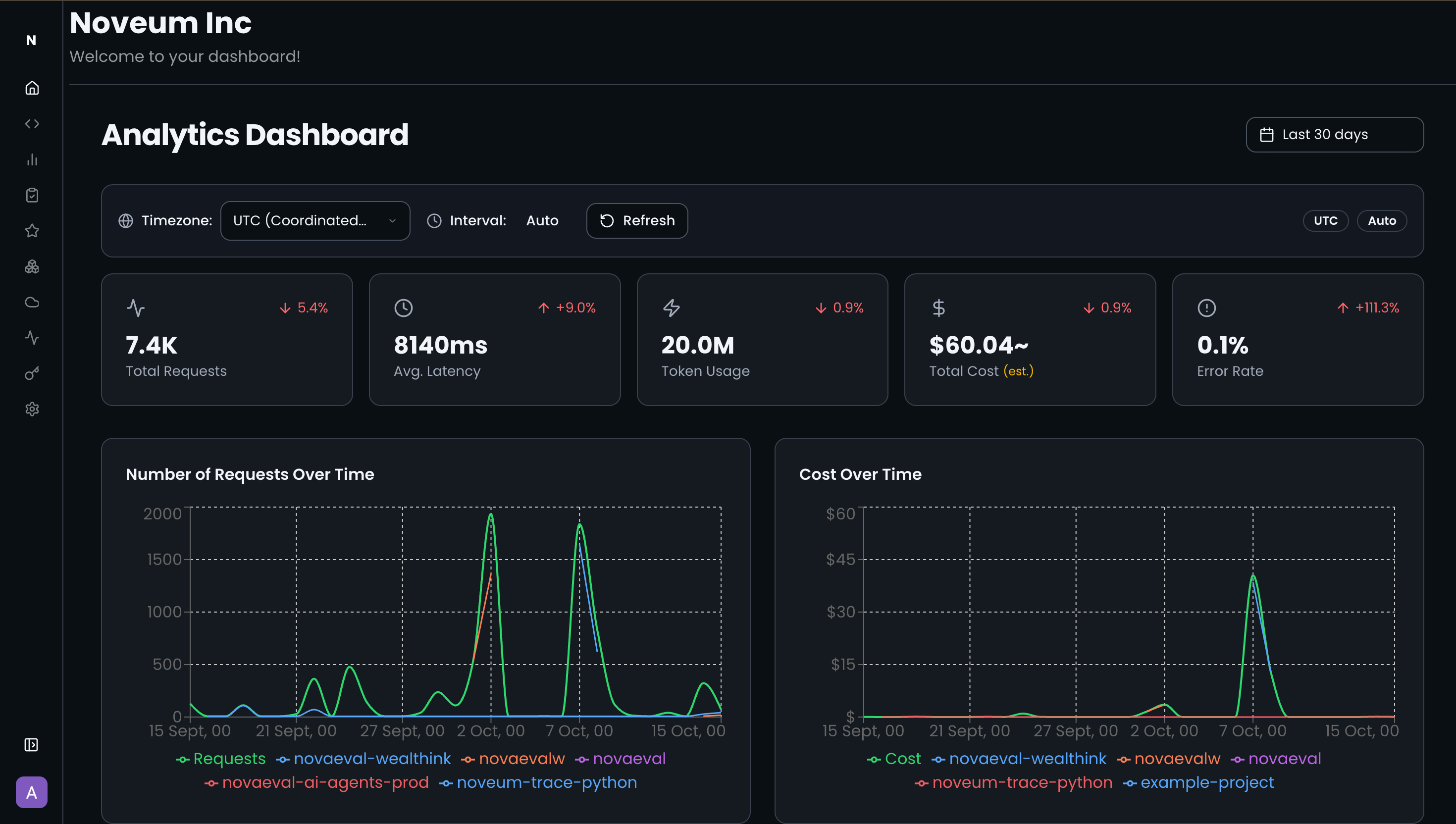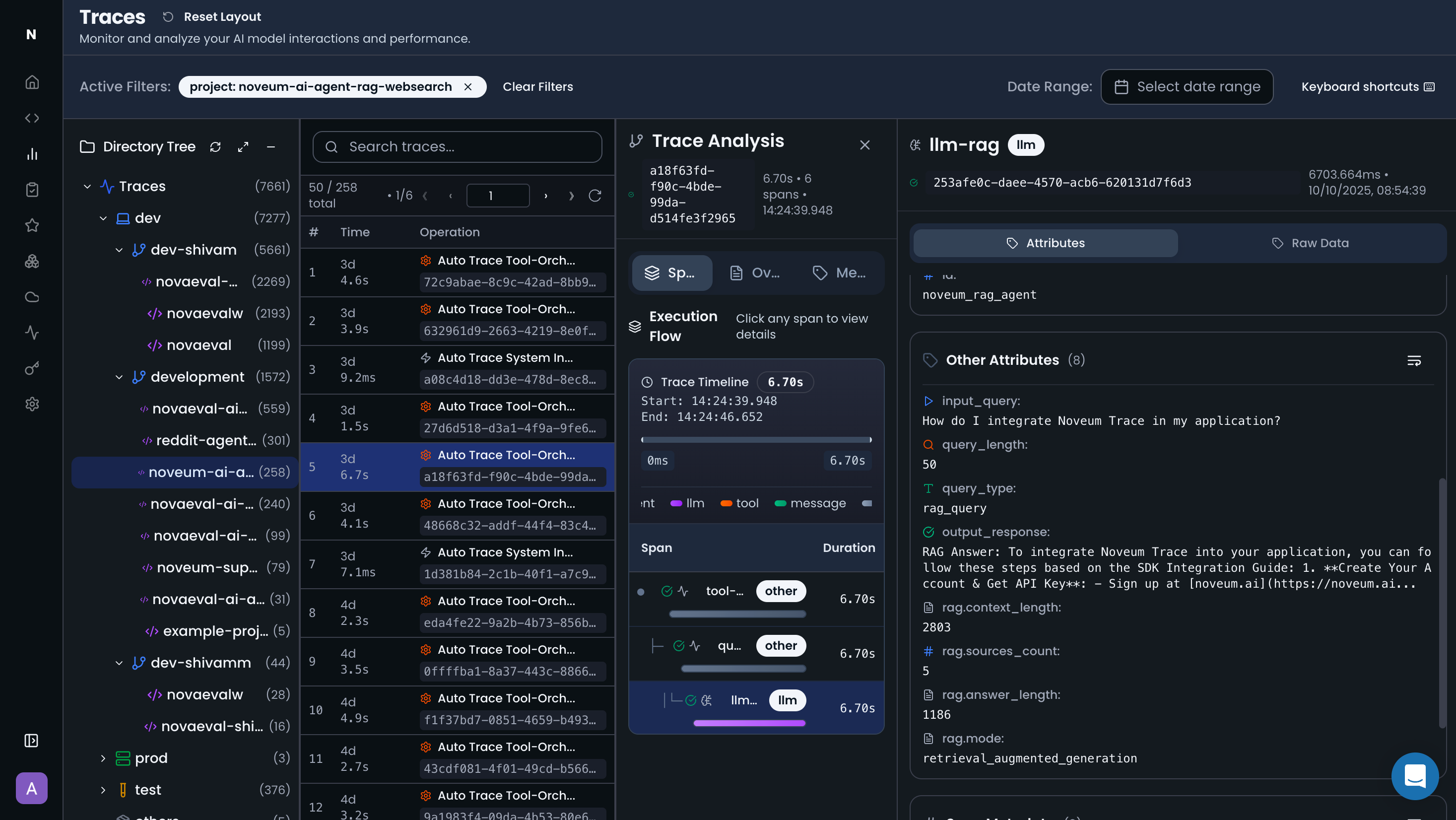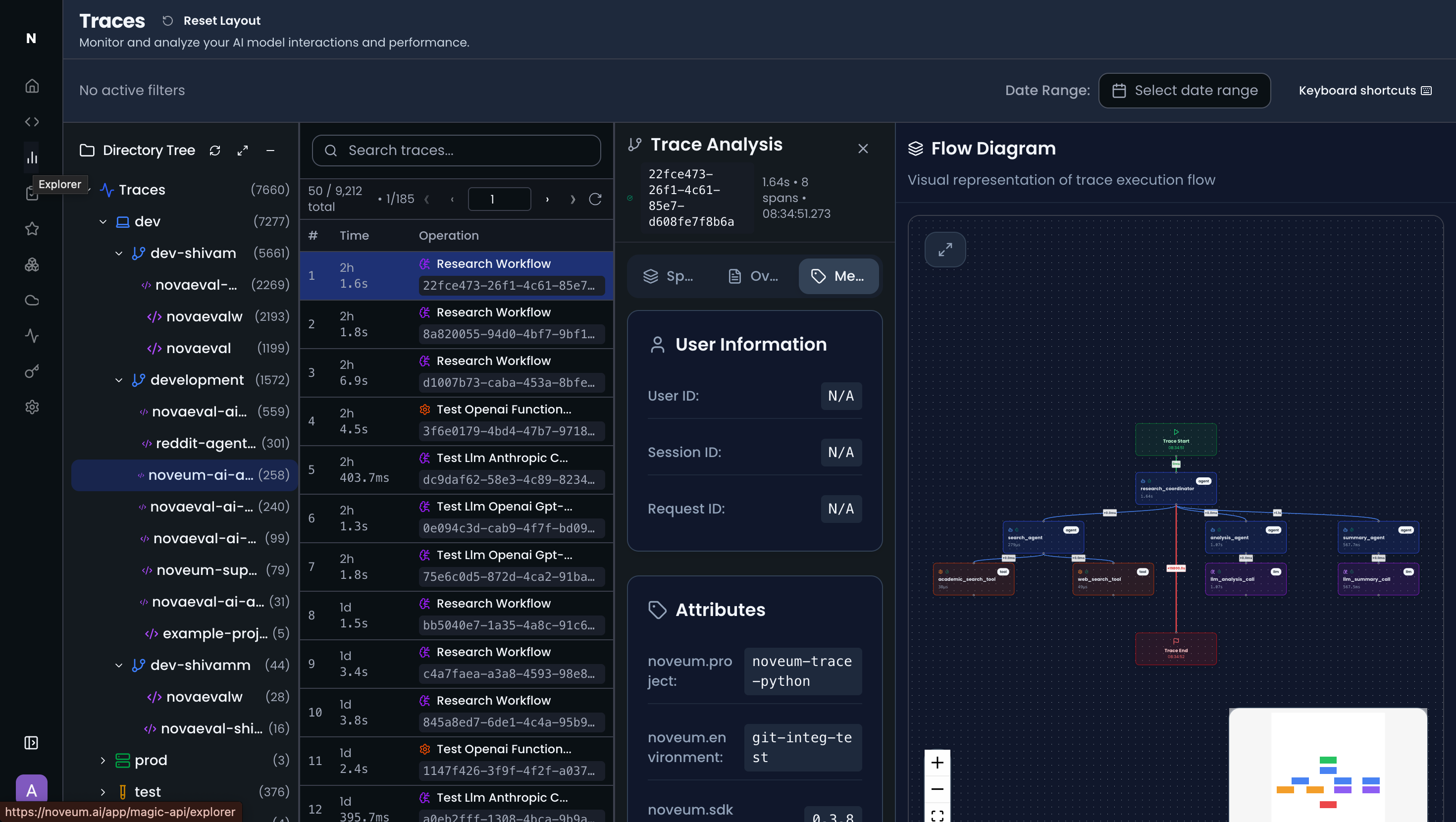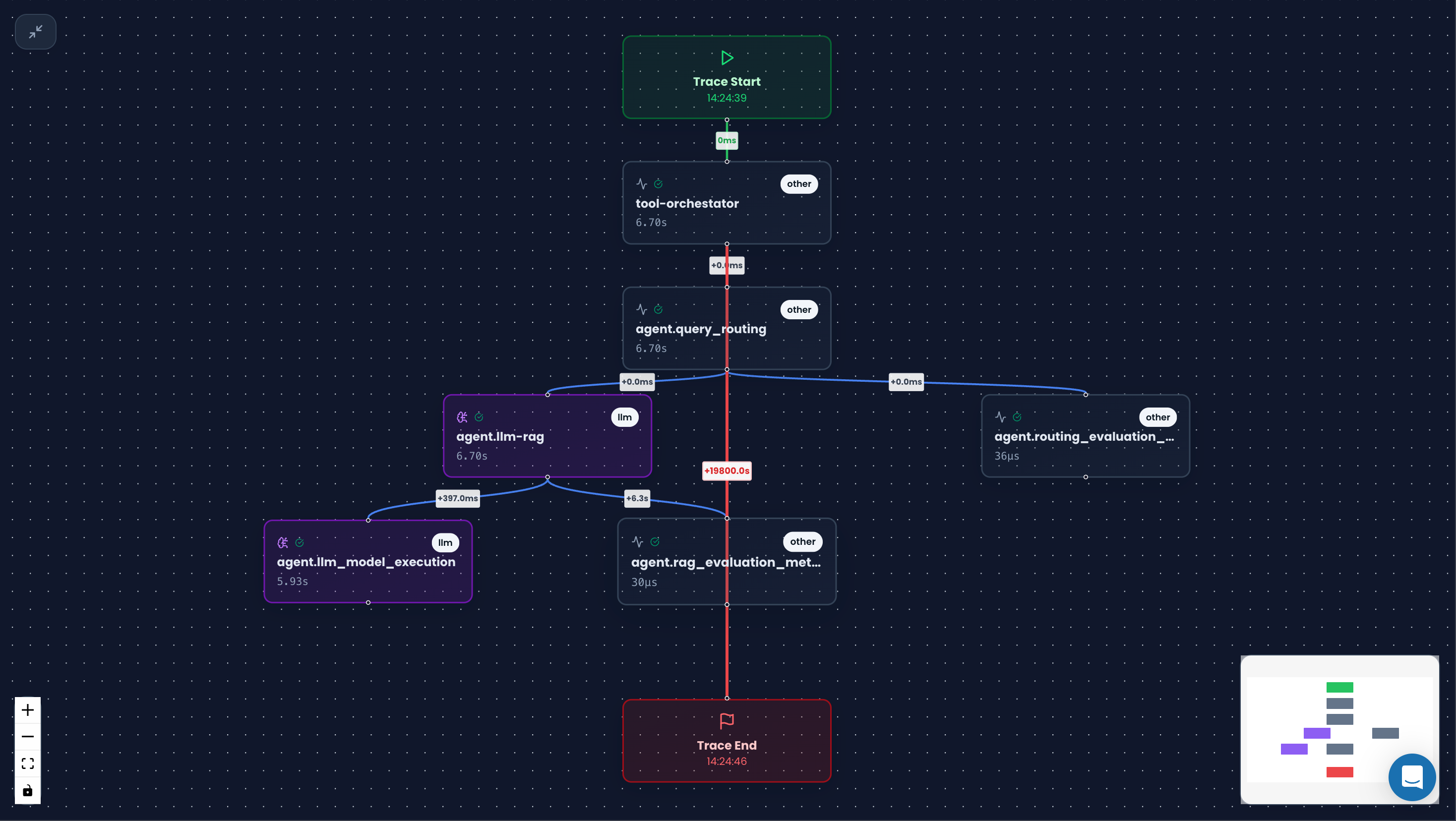🚀 Noveum.ai Overview
A unified observability, evaluation, and autofix platform for modern AI applications — including agents, LLMs, and RAG systems.
Welcome to Noveum.ai—the end to end observability and autofix platform built specifically for AI applications. Whether you're building LLM-powered chatbots, RAG systems, multi-agent workflows, or any AI-driven application, Noveum provides the insights you need to understand, Propose the fixes and autofix it for you.
Platform Overview
Click on images to view fullscreen
🔄 How Noveum Works - Step-by-Step Process
Install & Setup
Add noveum-trace SDK to your project
Add Tracing
Wrap your Agent calls to extract the traces
Monitor & Analyze
View traces in real-time over dashboard
Insights & AutoFix
Explore scores, Analyze Reasoning and Autofix
🚀 Core Capabilities
🔍 Complete AI Tracing
- Complete trace of all AI agent calls
- Hierarchical trace visualization with spans
- Python SDK for seamless integration
- Minimal code changes required
📊 Dashboard Analysis & Scoring
- Analyze AI calls with detailed insights
- Score performance with reasoning
- Interactive trace visualization
- Real-time monitoring and metrics
🛠️ Solution Proposal & Autofix
- Intelligent solution recommendations
- Automated fix suggestions
- Performance optimization guidance
- Proactive issue resolution
Why AI Applications Need Specialized Observability
Traditional monitoring tools fall short when it comes to AI applications because they don't understand:
- AI-Specific Metrics: Token usage, model costs, prompt effectiveness
- Complex Workflows: Multi-step RAG pipelines, agent interactions, tool usage
- Context Flow: How data moves through embeddings, retrievals, and generations
- Cost Attribution: Which operations drive your AI spending
- Quality Metrics: Beyond latency - understanding output quality and relevance
- Custom Evals: Scorers tailored to your specific use case and business requirements
Noveum.ai bridges this gap with purpose-built observability for the AI era.
🔄 Complete Workflow - How it happens
Step 1: SDK Integration
Add tracing to your code with minimal changes using context managers:
Step 2: Trace Collection - noveum-trace
Comprehensive end-to-end tracing for your AI application
- LLM Operations: Model calls, token usage, costs
- RAG Pipelines: Document retrieval, embeddings, context assembly
- Agent Workflows: Multi-agent interactions, tool usage, decision trees
- Tool Calls: Function calls, tool executions, parameter passing
- API Calls: External service requests, responses, status codes
- DB Calls: Database queries, transactions, connection pooling
- Custom Operations: Business logic, external APIs, data processing
Step 3: Platform Visualization
View and analyze traces in the Noveum dashboard:
- Hierarchical Trace Views: Complete workflow visualization
- Performance Metrics: Latency, throughput, error rates
- Cost Analysis: Token usage, provider costs, optimization opportunities
- Real-time Monitoring: Live dashboards and intelligent alerting
Step 4: Background ETL Processing
In the background, automated ETL jobs continuously process your traces:
- Dataset Creation: Convert traces to evaluation datasets automatically
- Model Evaluation: Run systematic evaluations with NovaEval scorers
- Score Generation: Calculate performance metrics and quality scores
- Dashboard Updates: Push results to real-time dashboards for analysis
Step 5: Score Visualization & Reasoning
Access detailed insights through the Noveum Dashboard:
- Call-by-Call Analysis: View scores and reasoning for every individual AI call
- Performance Breakdown: Understand why certain calls performed better or worse
- Reasoning Transparency: See the evaluation logic behind each score
- Interactive Exploration: Drill down into specific traces and spans for detailed analysis
🛠️ Core Platform Components
Python SDK
Context manager-based tracing for seamless AI application integration

NovaEval Engine
Comprehensive evaluation system with automated model comparison and scoring

Noveum Platform
Real-time dashboard with AI-specific visualizations and team collaboration

Key Components
- Traces - Complete request journeys through your AI application from input to output
- Spans - Individual operations within traces including LLM calls and tool usage
- Attributes - Rich metadata including model parameters, costs, and performance metrics
- Events - Timeline tracking of errors, decisions, and state changes in AI workflows
🎯 Complete End-to-End AI Monitoring
Noveum traces everything, provides powerful dashboards for visualization, and offers comprehensive scoring and evaluation - delivering complete end-to-end monitoring for your AI applications.
🚀 Quick Start Actions
Get Started
5-minute setup guide to start tracing your AI applications
Quick Setup →View Dashboard
Explore the Noveum platform and see your traces in action
Launch Dashboard →Try Examples
See complete working examples of AI tracing in action
View Examples →🤝 Community & Support
- 💬 Discord Community: Join our Discord
- 📧 Email Support: [email protected]
- 🐛 Bug Reports: GitHub Issues
- 📖 Knowledge Base: Help Center
Ready to get started? Head to our SDK Integration Guide to begin tracing your AI applications in under 5 minutes!
Built by developers, for developers. Noveum.ai understands that AI applications are different, and we've designed our platform from the ground up to meet their unique observability needs.
Get Early Access to Noveum.ai Platform
Be the first one to get notified when we open Noveum Platform to more users. All users get access to Observability suite for free, early users get free eval jobs and premium support for the first year.


